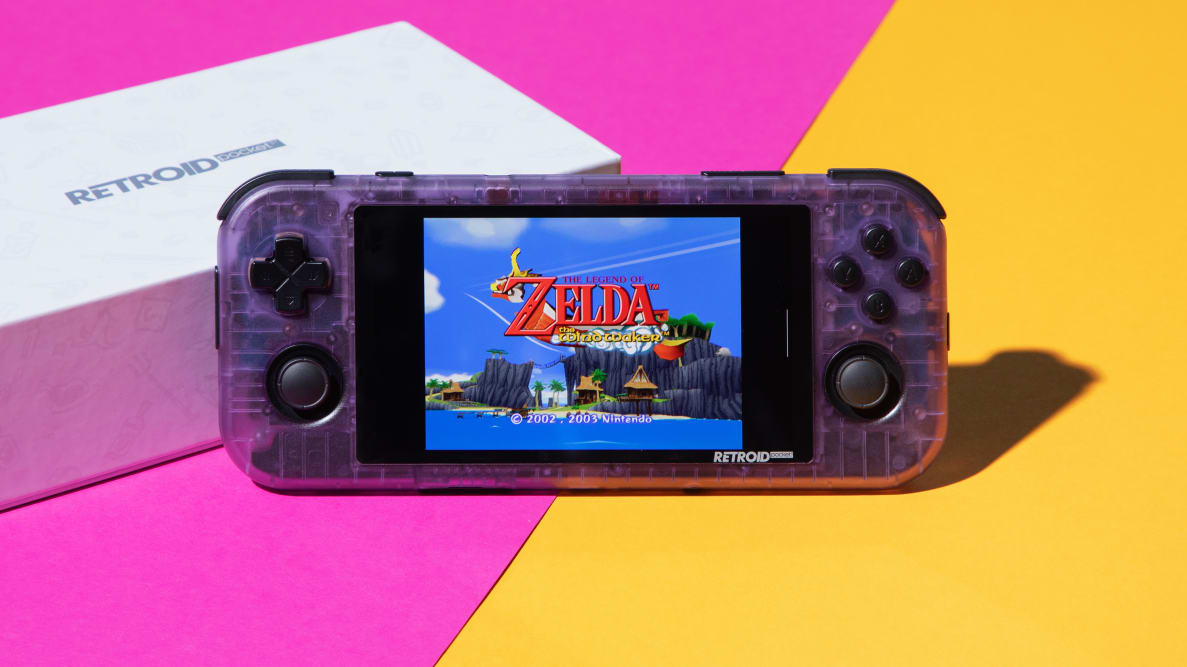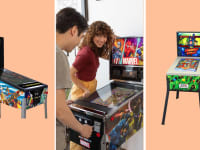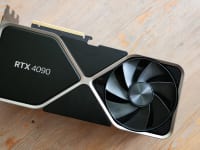Pros
-
Increased screen size
-
Great feeling buttons
-
Interesting colorways
Cons
-
Long shipping times
-
Layout is a bit cramped
About the Retroid Pocket 3+
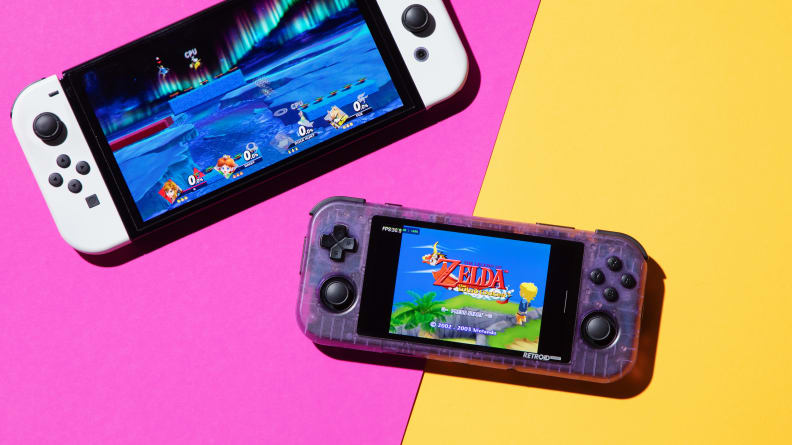
The Pocket 3+ is smaller than the Nintendo Switch and Switch Lite.
Here are the specs of the handheld console we tested:
- Price: Starts at $149
- Processor: Unisoc Tiger T618
- Graphics: Mali G52 MC2 at 850MHz
- Memory: 4GB LPDDR4x at 1866MHz
- Storage: 128GB eMMC 5.1
- Battery: 4500mAh
- Display: 4.7-inch, 1334 x 750 pixels (16:9), 60Hz, IPS touch screen, max brightness 450 nits
- Connectivity: Bluetooth 5.0, dual-band Wi-Fi (2.4GHz and 5.0GHz), 3.5mm audio jack, USB-C in, 720p micro-HDMI out
- Operating system: Android 11
- Colors: Retro, Indigo, 16 Bit, Orange, Black, 16 Bit (alternate US style), Clear Purple, Clear Blue
- Dimensions: 7.27 x 3.2 x .95 inches (at thickest point)
- Weight: 235 grams (8.28 ounces)
- Special features: Haptic feedback, pre-loaded with emulation and game streaming apps, Micro SD card slot, included screen protector
Retroid once again went all-in on retro console and handheld-themed colorways, bumping the available models up to eight from the five Retroid Pocket 2+ options. We reviewed the Clear Purple color, which references Nintendo’s Atomic Purple Game Boy Color, Game Boy Advance, and Nintendo 64. While the base Retroid Pocket 3+ costs $149, choosing Clear Purple or Clear Blue will raise the price to $154.
On first boot, you’re prompted to choose between Retroid’s proprietary game launcher that aggregates emulators in one easily accessible place; RetroidLauncher, or a basic Android 11 installation. You can freely switch between them at any time, and I primarily used the Android 11 interface for this review. Retroid hasn’t yet confirmed whether you’ll eventually be able to update to Android 12 or 13.
Retroid also sells grips for the Retroid Pocket 3 and 3+ to enhance their ergonomics. For $10 more, buyers can bundle in Hall Effect joysticks and upgrade their handhelds with sticks that lack dead zones and won't drift over time.
What we like
The build quality
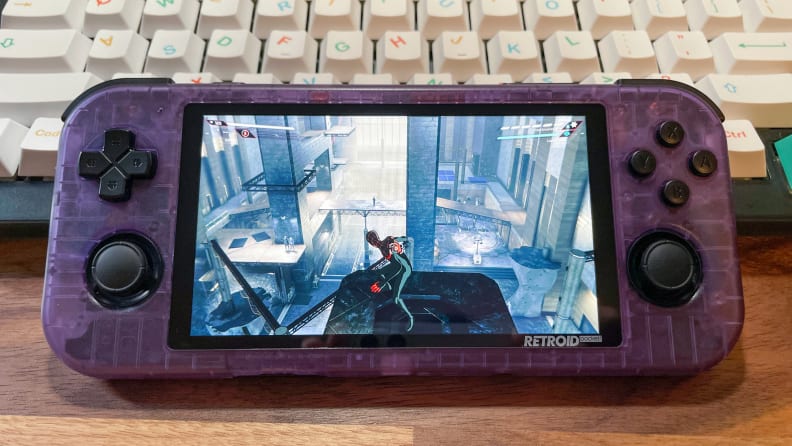
Thanks to the larger screen, game streaming is a much better experience on the Pocket 3+.
The Retroid Pocket 3+ looks suspiciously similar to the Nintendo Switch Lite at first glance. Apart from the smaller size and left thumbstick placement, the two gaming handhelds are nearly identical. The switch to a widescreen layout coming from the 4:3 Retroid Pocket 2+ is a welcome one that addresses most of the issues I had with that older system.
The Pocket 3+ features the same layout and screen as the Retroid Pocket 3 (which itself uses the same older internals as the Pocket 2+). There are two full short thumbsticks that you can click for L3 and R3 functionality, a D-pad on the left side above the stick, a much wider body than the Pocket 2+.
Most noticeably, Retroid has done away with the clunky “chin” under the screen. The volume rocker has been shunted to the left edge, the home button moved to the right, and the power, select, and start buttons moved to the top.
Although the volume and home buttons now sit under where your left and right index fingers rest while playing, they’re stiff enough that I never accidentally activated them. In fact, apart from the D-pad, all of the buttons on the Pocket 3+ are uniformly excellent, even if the travel on the triggers is a bit short.
The face buttons on our Retroid Pocket 2+ unit had a jagged, “crusty” quality to them and I often missed time-sensitive jumps, but that isn’t the case here. The rubber dome switches used under the A, B, X, Y buttons give them a snappy and responsive feel without the rattle found in modern controllers, and have a surprising depth. I honestly like them more than the face buttons on my Steam Deck, Nintendo Switch, and Xbox Core Wireless Controller.
If you don’t like the face buttons and want to change the colors or swap between rubber dome switches or conductive pad switches (which are softer and less clicky), Retroid sells $5 kits for changing them out.
If you have a Retroid Pocket 3, which uses the same shell, you can also buy the Pocket 3+ PCB for $85 and upgrade it yourself.
The only sticking point in the design is the D-pad. While the face buttons are great, the D-pad is just mediocre. It’s shallow and clicky, and I had trouble pulling off complicated fighting game combos with it.
The colorful screen
Gone is the tiny 3.5-inch, 4:3 screen of the Retroid Pocket 2+; the Pocket 3+ packs a 4.7-inch, 1334 x 750 IPS display with deep contrast and rich colors (in part because of how glossy and reflective the finish is). While the Pocket 2+ can emulate up to some PlayStation 2 and GameCube games and stream games locally over Steam Link or Moonlight just fine, the size and aspect ratio presented some text legibility problems, especially for widescreen games. That’s all been fixed.
I had no problem streaming Control, Elden Ring, or Hades to the Retroid Pocket 3+ from my personal PC, and all of them looked great thanks to the screen’s dark blacks. I wouldn’t suggest running a text-heavy game like Disco Elysium or Baldur’s Gate 3, but I was able to stream Spider-Man: Miles Morales at 1080p at max settings to the Pocket 3+ with low enough input latency that it felt like native gaming.
The brightness range has also been expanded considerably. The Retroid Pocket 3+ tops out at 450 nits, which I consider bright enough to play outside, and drops to nearly black when the brightness is lowered to its minimum. The latter fix addresses a major complaint buyers had with the previous model, as some units didn’t get dark enough to comfortably play at night. I also didn’t notice any backlight bleed or bloom around bright objects.
Retroid has also upped the pixels-per-inch (PPI) of the Pocket 3+ to 326, which is what Apple considers “retina quality,” or the point where your eye can’t discern individual pixels any longer. That’s likely not a coincidence given that the display has suspiciously similar specs to the screen used in the iPhone 6.
Compare that 326 to the 229 PPI of the Pocket 2+, or the 267 PPI of the Switch Lite, and the increased pixel density becomes immediately apparent. Thankfully, the Retroid Pocket 3+ can push those pixels just fine thanks to its more powerful hardware.
The improved performance
The biggest selling point of the Retroid Pocket 3+ is what the company claims is a 50% improvement in performance over the Pocket 2+ and Pocket 3. Everything has been clocked higher, from the processor to the newer GPU, to the RAM (which you get 4GB of instead of 2).
I couldn’t quantify if the increase was exactly 50%, but you’ll feel the difference. While the Pocket 2+ could handle everything up to PlayStation 2 and GameCube with ease, anything newer was a choppy mess. The Retroid Pocket 3+, however, can finally play many of the titles the Pocket 2+ couldn’t—though, for a $149 handheld, don’t expect 100% perfect playability across the board.
On the PlayStation 1 side, I was able to upscale Tony Hawk’s Pro Skater 2 to 6x native resolution, or 1080p, and remain locked at 60 frames per second (fps). That level of performance was seen in every game I tested, but PlayStation 2 was dodgier.
I played through the opening sequence of Final Fantasy X locked at 30 fps and was able to run Guilty Gear X2 Reload and other less-demanding 2D titles at full speed using the included AetherSX2 emulator, but the experience wasn’t perfect. Soul Caliber 2 stuttered and ran so slowly that it was unplayable, but that was my worst-performing exception.
Like with past Retroid handhelds, the community maintains a spreadsheet with individual game performance. Flagship titles like Kingdom Hearts, Persona 3 and Persona 4, Devil May Cry 2 and others run perfectly without the need for tweaks or scaling down the resolution. On the plus side, thanks to the screen size and performance increase, PlayStation Portable games will now run perfectly nearly across the board.
Nintendo 64 performance was also uniformly excellent, which is to be expected. What wasn’t expected is that the Retroid Pocket 3+ can run GameCube, Wii, and even some Switch games at full speed. Super Smash Bros. Melee runs at 60fps with only minor occasional dips at full resolution on the Dolphin for Handheld emulator, and The Legend of Zelda: The Wind Waker similarly ran at a steady 30fps during my testing.
I didn’t test any Wii or Switch games, but compatibility there is more hit or miss. Still, the fact that some of these games will run at all on a $149 Android handheld is impressive.
One of the biggest improvements, in my book, is that Retroid has upped the internal storage to 128GB. That’s likely more than enough for most people—you might not even have to buy an SD card.
What we don’t like
Ergonomics are a bit funky

The down-firing speakers are unfortunately muffled and hard to hear.
Retroid made some sacrifices to achieve the Pocket 3+’s slim, horizontal design. The annoying chin below the screen from the Pocket 2+ is gone, but so are the excellent front-firing speakers and line of easily accessible buttons.
Instead, the Retroid Pocket 3+ uses downward-firing speakers that my fingers naturally covered when playing a game. I wish the Pocket 3+ was a touch taller, as my pinkies dangle at the bottom. Tucking them upwards to the body of the device places them right over the speakers, further muffling the sound. The speakers are plenty loud, but because of their orientation, they don’t provide the clearest sound even when unobstructed.
Thankfully, because the Retroid Pocket 3+ is an Android device, you can pair your favorite wireless earbuds or headphones and they should work just fine. I’ve seen some complaints of audio latency over Bluetooth, but didn’t notice substantial lag when paired with my Sony WH-1000XM3 (so newer models like the WH-1000XM5 should work just fine).
Moving the volume rocker and home buttons to the outer edges makes them more annoying to press while gaming, but the new combined Select/Start rocker on the very top next to the right shoulder button is my least favorite new addition. It’s just not intuitively placed, especially in menu-heavy games.
The decision to move the D-pad above the left thumbstick is also baffling, as you’ll likely be playing more 3D games on the Retroid Pocket 3+ than the Pocket 2+. It’s not uncomfortable, but it feels less-than-optimal if you’re using that stick.
Retroid’s release cadence
Apart from the potentially long shipping times (it took us a month to get a unit shipped directly from Retroid in China), I can’t dance around the fact that this is the third Pocket device Retroid released in 2022.
Make no mistake, the Retroid Pocket 3+ is a good product overall, priced well, and it’s clear the company cares about attention to detail given the range of colors and DIY items available for purchase. They even offer good customer service and after-purchase support, something other retro handheld manufacturers don’t.
But if you buy the Pocket 3+, just prepare (or gird) yourself to deal with potential purchase FOMO if and when the Retroid Pocket 4 and 4+ are announced. Retroid hasn’t officially revealed anything yet, but I wouldn’t be surprised if at least one new model launches sooner rather than later.
Should you buy the Retroid Pocket 3+?
Yes, unless you’re happy with the Pocket 2+

GameCube emulation is much more attainable this time.
The Retroid Pocket 3+ is a slim, pocketable Android gaming handheld that fixes all of the problems I had with the previous model. The large and vibrant screen is big enough to handle game streaming and newer console emulation, and battery life is decent, with about five to seven hours per full charge depending on what you’re playing. (Although I noticed the battery drained by about 10% per day on standby, a problem I’ve also had with the Switch Lite).
The main issue is the price. At $149, the Pocket 3+ fits a comfortable niche. Retroid has delivered a device that’s 50% more powerful than the Pocket 2+ at 50% greater cost, and it easily outpaces similarly priced emulation handhelds like the Anbernic RG353M while remaining affordable.
If you’re looking to buy a single gaming handheld, though, a Nintendo Switch Lite is only $50 more, or even less used, and you won’t have to deal with the hassle of finding ROMs or tweaking emulator settings. For the budget conscious who just want to play older retro titles, the Retroid Pocket 2+ is still a great deal.
But if you want a capable handheld that can run everything from NES up to GameCube games and sometimes even beyond, the Retroid Pocket 3+ is your best option at the $150 price point. The excellent Ayn Odin is the next step up and even comes in clear purple, but it’s also $240. If you can live with a smaller screen and slightly worse performance, the Pocket 3+ can’t be beat.
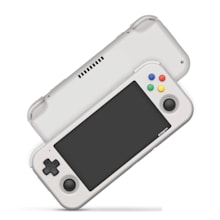
The Retroid Pocket 3+ provides an excellent mix of performance and value for retro game emulation.
Meet the tester
Jonathan is an Electronics Editor for Reviewed specializing in gaming gear and has experience with everything from controllers to benchmarking the latest GPUs. He was previously the Web Editor at The Architect's Newspaper.
Checking our work.
Our team is here for one purpose: to help you buy the best stuff and love what you own. Our writers, editors, and lab technicians obsess over the products we cover to make sure you're confident and satisfied. Have a different opinion about something we recommend? Email us and we'll compare notes.
Shoot us an email
